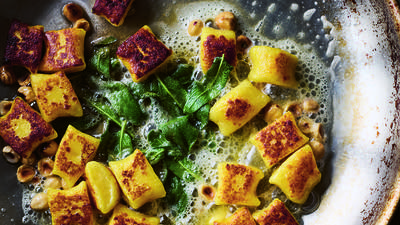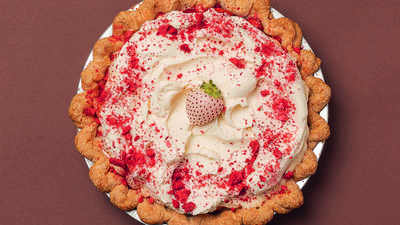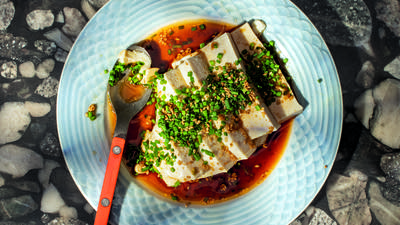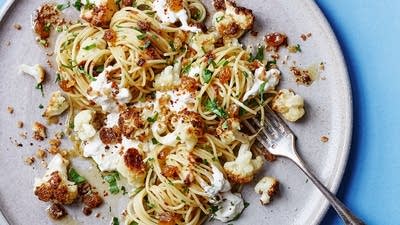
If you hang out in kitchen stores and food shops, you've probably seen salt blocks in the form of squares, rectangles, bowls and cups. Himalayan salt block cooking is a new way to cook, but the salt is as old as the hills. Mark Bitterman, author of Salt Block Cooking and co-owner of the specialty shop The Meadow in Portland, Ore., and New York City, explains how to use a salt block for cooking, curing and serving food.
Lynne Rossetto Kasper: If you haven't seen a salt block, it's hard to visualize.
 Mark Bitterman
Mark Bitterman
Mark Bitterman: They're not from this Earth, is the way they feel. It's essentially the crystallized soul of a 600-million-year-old ocean. It is this giant, luminescent chunk of salt that is infused with magnesium, iron, zinc, manganese and all these beautiful minerals that give it this preternatural, pink, crazy color.
Frankly when I first found salt blocks, it wasn't just their otherworldly beauty that attracted me to them, it was actually something physical about them. I swear to God I would walk around with one in my hand for days. I could never put them down. I'd keep one in my pocket that was smaller.
LRK: How big is a salt block usually?
MB: They range in size. They can be a small little plate, just a 2-inch-by-3-inch thing to put a pat of butter on, or they could be as big as a 9-inch-by-18-inch-by-2-inch giant slab that you could use to present food on.
LRK: You actually cook on these?
MB: You do. They have tremendous thermal properties. They hold any temperature very well. You can freeze them in the freezer, you can heat them up on the stovetop, the gas grill or any grill to an excess of 500 degrees Fahrenheit. I cook on them at 550-600 degrees Fahrenheit all the time.
LRK: Can you put them in the oven?
 Salt Block Cooking
Salt Block Cooking
MB: You can. You temper them first on the stovetop so they are used to being in the heat; then, you could throw them in the oven. You could bake walnut scones on them, pizza dough, dinner rolls, whatever you like.
LRK: The big question here: What does a salt block do for food that other equipment doesn't?
MB: You can take advantage of a bunch of different properties that they have to offer. They're very heavy, so you could use them to compress food by putting them on top of something. For example, heat up your salt block on the grill, throw a piece of butterflied chicken down on the grill and then sandwich it underneath that piping hot salt block. It will press it, firm it and sear it with salt at the same time. You can also use it for its heat by heating it up and putting some scallops or flank steak on there. You can use it for its ability to cure food. Press two salt blocks around a piece of salmon and you get gravlax.
LRK: Do things taste very salty when they are prepared using a salt block?
MB: That's the trick. Whenever I hear that someone has food that came out too salty, it's inevitably the result of maybe not using quite the right technique. If you're heating with a salt block, when you get it hot enough, you're really hitting it with that hard, fast sear -- that quick, intense amount of energy that just pumps on the food. You get that glaze on it -- it's a salty glaze just on the surface -- and the food is seasoned to perfection.
If you're using it for serving something, say some mozzarella and green apple or a watermelon and feta and mint salad, you feather the food out or fan it out on the salt block so that not all the food is in contact with the salt. Even if it's on the salt for a little while, only a small edge of that food gets the salt on it.
 Bitterman's recipe: Watermelon and Feta on a Salt Block
Bitterman's recipe: Watermelon and Feta on a Salt Block
LRK: What should you look for when you're buying a salt block?
MB: The main thing is to buy a salt block that's appropriate for the intended use. If you're going to be using it for serving, curing or for chilling, you can buy a grade of salt block that has more irregularities and fractures with crystalline imperfection. It'll be very, very beautiful, but not as structurally rigid as a salt block that you might need for cooking.
For cooking, you want a salt block that has amazing crystalline uniformity. We actually have a grade called a cookware-grade salt, which is specifically designed for that. That's necessary because there are a lot of stresses that go on the salt block when you're heating it up on the stovetop.
LRK: You're looking for a salt block that isn't distinctively patterned, something that's more one muted tone?
MB: Correct. The most boring-looking salt blocks (which are still tremendously exciting-looking) are the best ones for cooking.
LRK: How thick does it have to be?
MB: I'd definitely recommend going with a salt block that is at least 2 inches thick for any high-temperature cooking application, because it gives you a lot of structural support. Thinner ones tend to have fissures and then they can crack and break on you.
It's not a catastrophe if it does break. There's actually a side part of the book called 15 Ways to Celebrate a Broken Salt Block because you can do lots with it once they break. But it's not as useful for cooking. You should get a nice 2-inch-thick one for cooking. If you're using it for serving, it does not matter how thin it is. Sometimes the 3/4-inch, thin ones are really beautiful little plates.
LRK: Can I get it wet? How can I clean this thing?
MB: I put a giant 9-inch-by-9-inch-by-2-inch, 12-pound salt block in my dishwasher as an experiment. I closed the door, ran it, opened the door -- there was no salt block. Don't do that.
What you do is you just get it gently moist with a sponge, hit it with a green scrubbie or a stainless steel scouring pad, wipe it, and repeat that process until there are no more adhering proteins. You do not need to get it any wetter than that, you do not use any soap because it's naturally anti-microbial. You just pat it dry with a paper towel and you're good to go.
Before you go...
Each week, The Splendid Table brings you stories that expand your world view, inspire you to try something new, and show how food connects us all. We rely on your generous support. For as little as $5 a month, you can have a lasting impact on The Splendid Table. And, when you donate, you’ll join a community of like-minded individuals who love good food, good conversation, and kitchen companionship. Show your love for The Splendid Table with a gift today.
Thank you for your support.
Donate today for as little as $5.00 a month. Your gift only takes a few minutes and has a lasting impact on The Splendid Table and you'll be welcomed into The Splendid Table Co-op.




